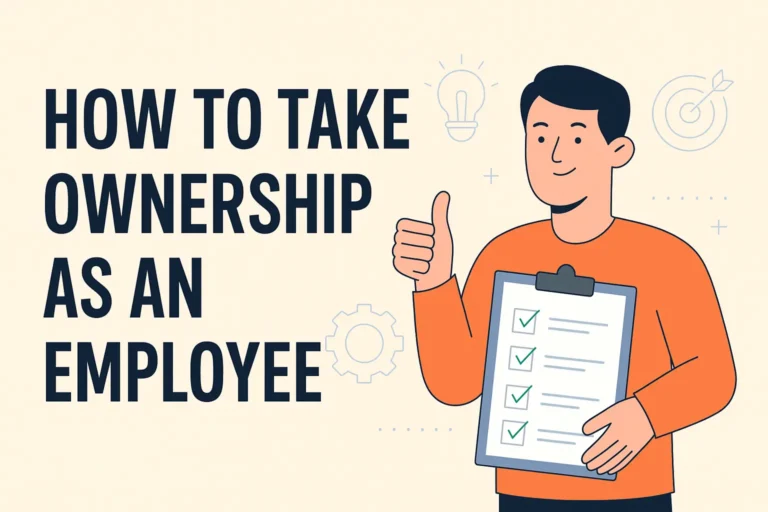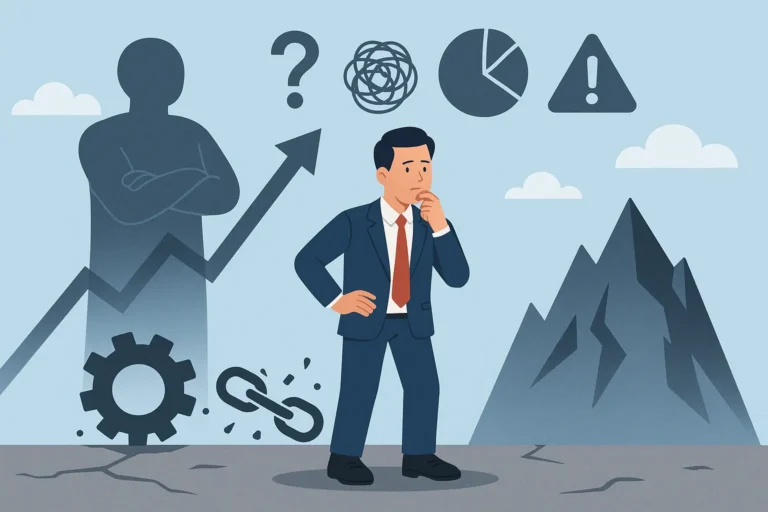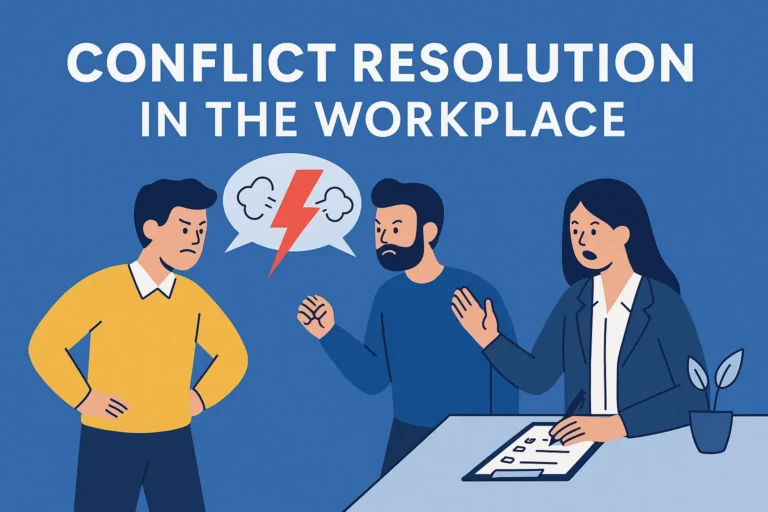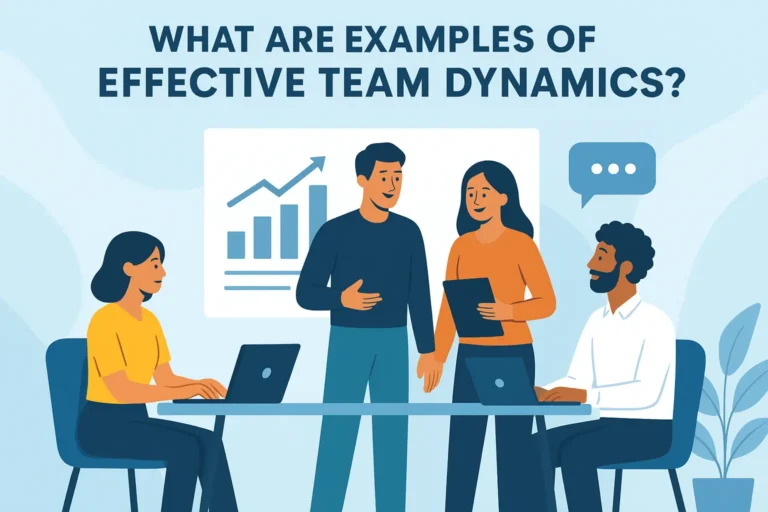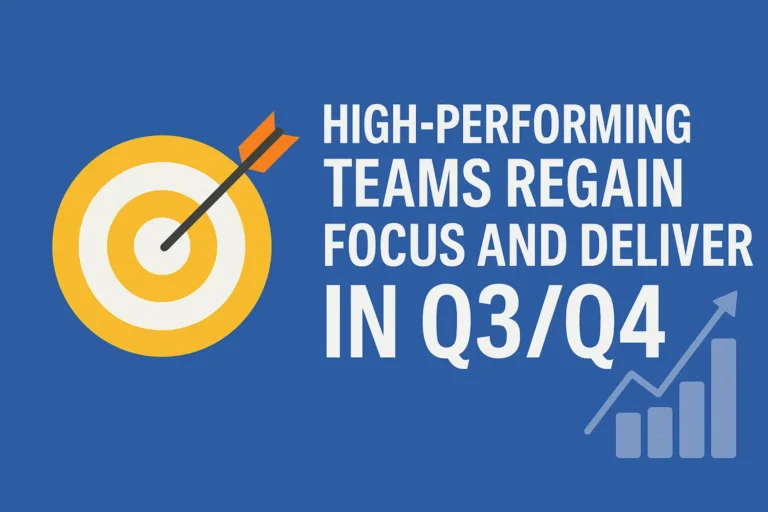The Calm Decision System [Make Better Decisions Under Pressure]
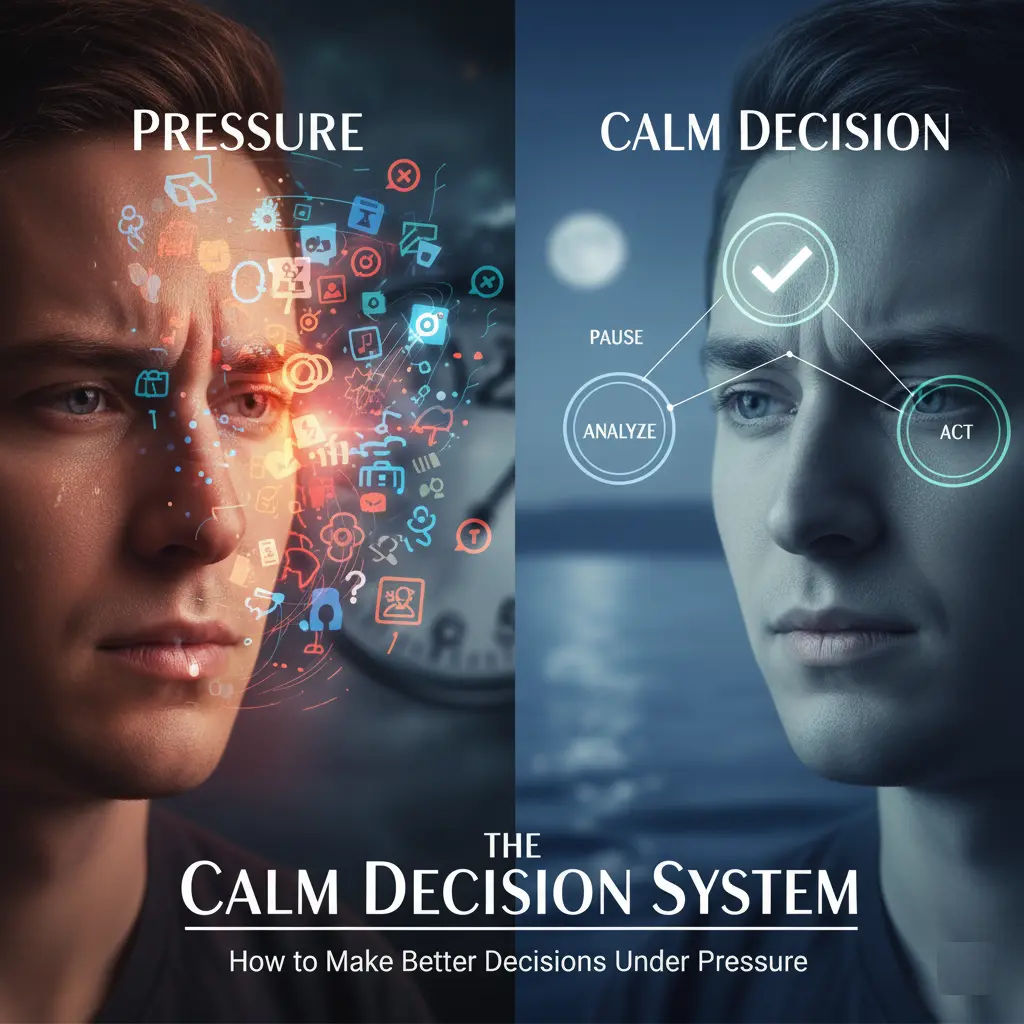
You’re under pressure.
A decision has to be made — fast. The emails keep coming, your phone won’t stop buzzing, and everyone wants an answer right now.
In those moments, thinking clearly feels almost impossible.
Your heart races, your focus shrinks, and your brain goes into survival mode. It’s not that you don’t know what to do — it’s that stress makes your thinking louder, not smarter.
In my work with leaders and teams, I’ve seen how pressure changes the way we think. When the stakes rise, the emotional part of the brain — the amygdala — takes over, while the prefrontal cortex, the center of logic and planning, starts to fade. That’s why we rush into choices we later question.
The truth is, calm decisions aren’t slower — they’re clearer.
They come from rhythm, not reaction.
That’s what The Calm Decision System is built for: a simple, repeatable method to turn chaos into clarity — step by step.
You can’t stop pressure, but you can change how you move through it
Start Your Calm Decision Journey
Build clarity in minutes a day with the core Calm Decision System. Ideal for: Individuals, Entrepreneurs, leaders Executives, coaches, and creators ready to build calm, high-performance systems in leadership, business, and life.
The Starter Deck
€4.90
The Clarity Toolkit
€39
The Calm Leadership System
€490
Why Pressure Blocks Good Decisions
Your Brain on Pressure
When pressure rises, your brain doesn’t think — it protects.
The amygdala, the emotional command center, takes over, while the prefrontal cortex — the area responsible for logic and clarity — temporarily goes offline. In those moments, urgency feels like intelligence. Speed feels like control. But clarity disappears.
Research from the Harvard Business Review and the American Psychological Association (APA) confirms that stress narrows perception and reduces problem-solving capacity. When we rush decisions, we aren’t leading — we’re reacting.
Everyday Examples
In business, leaders under pressure often rush into decisions just to end uncertainty.
At work, teams argue over quick fixes instead of solving the real issue.
In relationships, people say things they don’t mean because silence feels heavier than speaking.
Different settings, same pattern — pressure turns reflection into reaction.
Experience Insight
As a decision coach, I’ve noticed that people rarely regret thinking too long — they regret acting too fast.
The moment they pause, they realize the problem wasn’t their decision itself, but the speed that drove it.
Calm doesn’t mean slow. It means steady.
Reflection Prompt
“What happens in your body when urgency hits — and how long does it take before you start thinking again?”
This reflective question begins the process of awareness — the first step in the Calm Decision System.
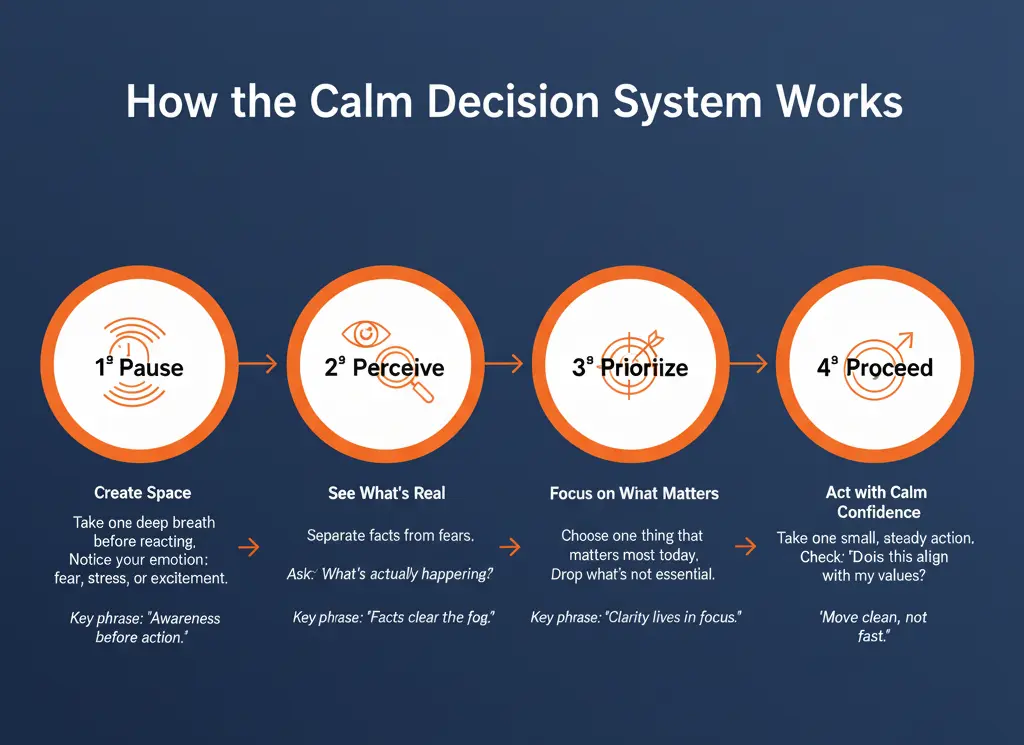
Best Prompts for The Calm Decision Deck
1️⃣ Pause & Presence
“Act as my calm reflection partner. Ask me 3 questions to help me pause before reacting.”
Link:
Open in ChatGPT
2️⃣ Identify the Emotion
“Guide me to name what I’m truly feeling before I decide.”
Link:
Open in ChatGPT
3️⃣ Facts vs. Fears
“Help me separate what’s really happening from what I imagine or fear.”
Link:
Open in ChatGPT
4️⃣ Clarity Compass
“Ask me 5 short questions to find what matters most right now.”
Link:
Open in ChatGPT
5️⃣ Option Reflection
“List 3 possible actions. For each, ask: ‘Does this align with calm clarity?’”
Link:
Open in ChatGPT
6️⃣ Decision Mirror
“Simulate a conversation where you mirror my reasoning back to me, highlighting contradictions.”
Link:
Open in ChatGPT
7️⃣ Inner Dialogue Reset
“Let’s rewrite my inner voice from panic to calm certainty. Guide me line by line.”
Link:
Open in ChatGPT
8️⃣ Action Alignment
“Help me define one single calm action I can take in the next 10 minutes.”
Link:
Open in ChatGPT
9️⃣ Post-Decision Reflection
“After I act, ask me 3 follow-up questions to review what I learned about myself.”
Link:
Open in ChatGPT
🔟 Calm Decision Ritual
“Guide me through a 3-minute breathing and reflection ritual before my next important choice.”
Link:
Open in ChatGPT
Section 3: The Calm Decision System (Core Framework)
Every effective decision follows a rhythm — not of speed, but of sequence.
The Calm Decision System brings structure to pressure by guiding your thinking through four clear steps: Pause → Perceive → Prioritize → Proceed.
This framework was developed through 12 months of prototype testing on SmartSuccessGuide.com and refined through work with leaders, entrepreneurs, and creative professionals. It transforms reaction into reflection — a repeatable pattern that keeps you composed even when stakes are high.
“Clarity isn’t found in control — it’s found in rhythm.”
Step 1: Pause
Question: “What emotion is leading this moment?”
When pressure spikes, emotion takes the driver’s seat. Pausing doesn’t mean waiting — it means reclaiming the mental space to notice what’s really happening inside you. The act of pausing separates signal from noise, creating the distance needed for accurate perception.
Step 2: Perceive
Question: “What is actually happening — not what I fear?”
Perception turns emotion into data. Calm perception means you name the facts without amplifying the fears. This is where awareness starts to reshape the narrative. You begin to see reality as it is — not as urgency paints it.
Step 3: Prioritize
Question: “What matters most right now?”
Not every problem deserves equal attention. Calm prioritization reorders your mind around impact, not impulse. It’s the decision-making equivalent of exhaling — reducing complexity to what’s essential.
Step 4: Proceed
Question: “What action aligns with calm clarity?”
Only now do you move — not faster, but cleaner. Calm action isn’t passive; it’s intentional. You act from alignment, not reaction, ensuring that what you do reflects what you value.
This four-step rhythm forms the foundation of The Calm Decision Deck, turning each reflective question into a practical tool.
Used consistently, it replaces emotional loops with designed responses — and that’s where true clarity lives.
“Pause to see. Perceive to understand. Prioritize to focus. Proceed to lead.”
From System to Practice – The Calm Decision Deck
The Calm Decision System works best when it becomes a habit, not just a concept.
That’s why it’s paired with The Calm Decision Deck — a digital toolkit that helps you practice calm clarity every day.
Each reflection in the deck is built around the same four steps you’ve just learned: Pause, Perceive, Prioritize, Proceed.
It gives you small, guided exercises you can use in real moments — before meetings, during tough choices, or anytime you feel pressure rising.
How the System Works in Practice
1️⃣ Pause – Slow down before you respond.
Take 60 seconds. Ask yourself: “What emotion is leading this moment?”
This short pause helps your brain shift from reaction to reflection.
2️⃣ Perceive – See the facts, not the fears.
Write down what’s actually happening. Label what’s real and what’s imagined.
You’ll notice your body relax as your thinking clears.
3️⃣ Prioritize – Focus on what truly matters right now.
Circle one key point that deserves your energy today.
Ignore the rest for now — clarity begins with focus.
4️⃣ Proceed – Act with calm clarity.
Take one small action that aligns with your values.
It doesn’t need to be perfect — just steady and intentional.
Why This Works
Most decision tools focus on speed and productivity.
The Calm Decision Deck focuses on awareness and rhythm.
It’s designed to reconnect your logic and emotions, helping you lead with both clarity and confidence.
Created through real coaching work with leaders and creatives, this system helps reduce reactive thinking and build inner steadiness.
“Try using this rhythm once a day — five minutes to pause, perceive, prioritize, and proceed. The results will feel calm, not forced.”
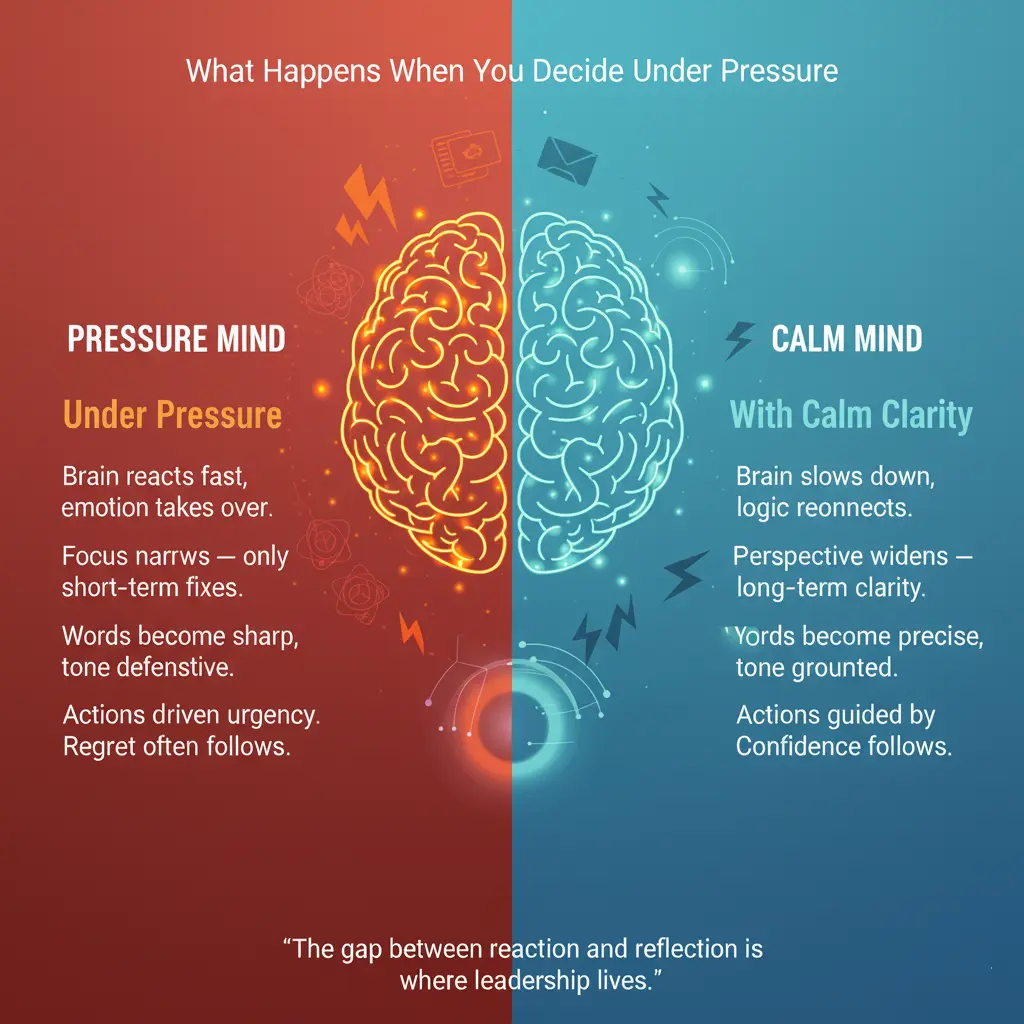
Section 5: Calm Decision in Real Life
Theory only matters when it changes what you do in the moment.
Let’s see how the Calm Decision System looks in real life.
A Real-World Story
Maya is a marketing lead racing toward a product launch.
Two key partners miss deadlines, the team chat explodes, and her calendar is packed with “urgent” calls. She feels that familiar rush — the need to fix everything now.
Instead of reacting, Maya opens her Calm Decision notes and walks through the four steps:
1️⃣ Pause — She stops for 60 seconds and takes one full breath. Her heart rate slows; her thoughts separate.
2️⃣ Perceive — She lists what’s real and what’s imagined. Real: two suppliers delayed. Imagined: “The whole launch will fail.”
3️⃣ Prioritize — She circles one action that matters most today — confirming a new delivery date.
4️⃣ Proceed — She sends one clear message instead of five frantic ones. The tone of the team changes within minutes.
The situation hasn’t disappeared, but her clarity has returned.
“Calm doesn’t erase pressure — it rewrites how you meet it.”
What People Notice
Early users of the Calm Decision Deck often share the same insight:
“I thought I needed more time to make better choices. I really just needed more space.”
That small pause before reacting becomes a habit; stress stops leading every move.
The Shift from Reaction to Reflection
Every leader, entrepreneur, or creator faces moments like this — where clarity feels out of reach.
The difference isn’t talent; it’s rhythm.
Applying the Calm Decision System doesn’t slow you down. It simply synchronizes thought and action, making you more intentional, not less responsive.
Try this micro-exercise right now:
Close your eyes.
Take three deep breaths.
Ask yourself, “What would calm clarity choose right now?”
You’ll notice how instantly your thinking widens — space appears where stress used to live.
“The moment you pause, you return to leadership.”
Conclusion – Calm Is a Decision
You can’t stop pressure from showing up.
But you can choose how you meet it.
Every day brings new challenges — tight deadlines, tough conversations, moments where everything feels urgent.
The difference between stress and strength isn’t luck or talent — it’s rhythm.
The Calm Decision System helps you find that rhythm.
It teaches you to pause before reacting, to see clearly before acting, and to move with purpose instead of panic.
Calm isn’t a mood — it’s a method.
And with the right system, every decision can become an act of clarity.
“Breathe. Decide. Lead — calmly.”
Call-to-Action
👉 Download The Calm Decision Deck
A reflective digital toolkit with 30 guided questions to help you slow down, reframe pressure, and act with calm precision — even when it matters most.
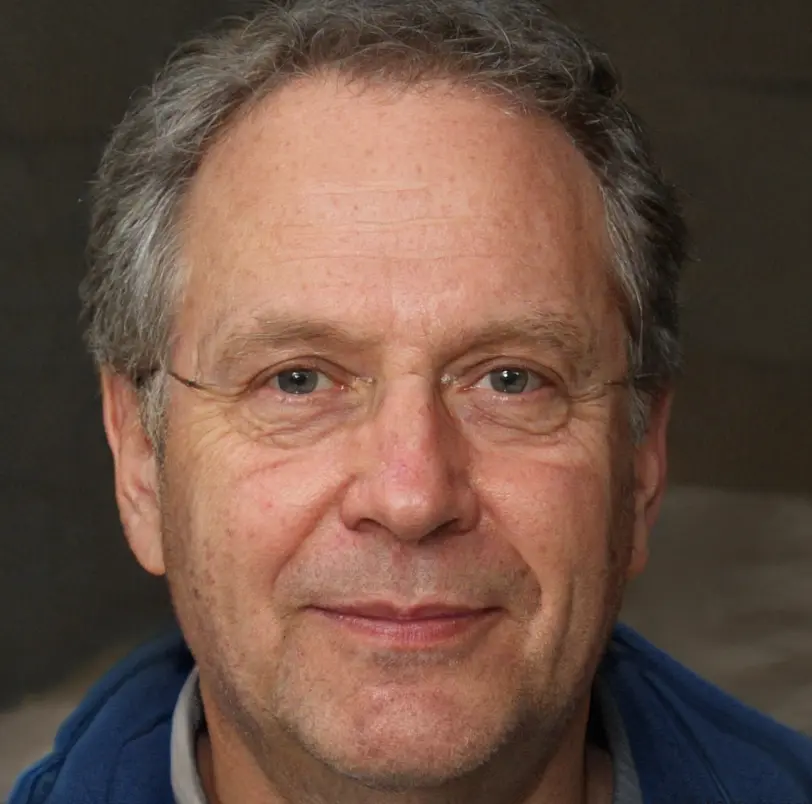
About the Author
Jonathan Savage is a leadership strategist who helps teams boost performance through clarity and structure. At SmartSuccessGuide.com, he shares proven frameworks for building focused, high-performing teams that deliver real results.

